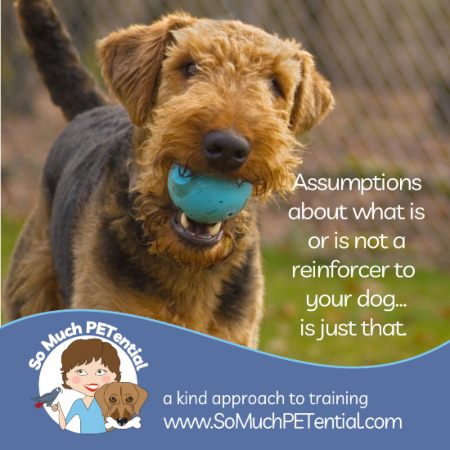Have you ever wanted to train your pet to be REALLY stubborn, meaning he will NOT do a behavior you ask him to do unless you show him the money or force him to do it?
I have seen many people who are actually very good at teaching this brilliance in their pet without realizing they are doing it. This is how it is typically done…
 The dog’s (I am using a dog in this example, but it can be any animal) handler simply needs to ask him to do something with a cue that has not sufficiently been taught with fluency, and then, if he does not do the wanted behavior, the handler repeats the cue and repeats it, or takes out a piece of food and begins luring him to do the behavior, or forces him to do what is asked.
The dog’s (I am using a dog in this example, but it can be any animal) handler simply needs to ask him to do something with a cue that has not sufficiently been taught with fluency, and then, if he does not do the wanted behavior, the handler repeats the cue and repeats it, or takes out a piece of food and begins luring him to do the behavior, or forces him to do what is asked.
Very quickly, that cued behavior breaks down as the learner stops (or never did) doing the wanted behavior when asked and does anything BUT the cued behavior with greater and greater frequency. And more often than not, it is the pet that gets blamed for being obstinate, bull headed, or dumb. But is that the case? Let’s delve into it a little.
I know I repeat this a lot because we all need reminders. It is consequences, not cues, that drive the future strength and rate of behavior. Behavior after all is simply an animal’s tool to get a consequence; and if that behavior serves to get something of value for the animal, then it is being reinforced and will continue. (Please see my posts on the four quadrants of consequences and classical conditioning.) The cue for a behavior is simply a signal for the learner that some sort of consequence is ahead, positive or negative depending on how it is taught.
In the case of the ‘stubborn’ dog, continuing to stand when asked to sit, or continuing to smell the flowers when called to come are actually what have taught him that the actual meaning of ‘sit’ or ‘come’ means stay standing or sniff the flowers UNTIL his trainer pulls out the good stuff (or a punisher).
Let’s pull out the behavior analysis hat to take a look at the situation here. Applied Behavior Analysis is a systematic approach to solving behavior problems by changing the environment in which the behavior occurs. It involves looking at the very specific behavior (such as a dog barking) in terms of what is giving that behavior purpose and value? What happened *immediately* prior to the behavior (antecedent) to set the whole ball rolling? And what happened *immediately* after the behavior to reinforce it (consequence)? It is how I have been taught to look at behavior.
A (Antecedent) – Owner asks Fido to sit
B (Behavior) – Fido stands and looks at owner
C (Consequence) – Owner asks and asks for a sit
Second ABC that follows this one. The consequence of the first ABC becomes the antecedent for the next behavior.
A (Antecedent) – Owner continues asking for a sit
B (Behavior) – Fido stands and looks at owner
C (Consequence) – Owner pulls out a piece of meat and lures Fido into a sit
Third ABC
A (Antecedent) – Owner lures the sit
B (Behavior) – Fido sits
C (Consequence) – Owner gives Fido piece of meat
If you look at behavior systematically in this way, you can see how his dog really is not so stubborn after all. He was actually taught to wait until his owner pulls out the meat and lures him until he does the behavior.
If a learner does not do a behavior that is cued, the better approach is to pause or walk away for a few seconds. That pause is important instead of reinforcing the wrong behavior. If you continue to not have success, then you may need to go back and work on teaching that behavior with more fluency in a variety of environments before adding back in the cue. If the cue has become so weakened, it may even be best to begin using a new cue that is taught with great consistency.
This is a great example of why teaching the behavior first with great positive reinforcing consequences builds strong behaviors. And, if you are having problems teaching a behavior there are so many factors that go into why your learner is having difficulty. Please click here to read some examples.
Always, it is important to remember, there is a reason why behavior happens.






